Archer MR200 V4 User Guide
- About This Guide
- Chapter 1 Get to Know Your 4G LTE Router
- Chapter 2 Connect the Hardware
- Chapter 3 Log In to Your 4G LTE Router
- Chapter 4 Set Up Internet Connections
- Chapter 5 QoS
- Chapter 6 Network Security
- Chapter 7 Parental Controls
- Chapter 8 SMS
- Chapter 9 Guest Network
- Chapter 10 NAT Forwarding
- Chapter 11 Specify Your Network Settings
- Chapter 12 Administrate Your Network
- FAQ
- Authentication
Chapter 12 Administrate Your Network
This chapter introduces how to change the system settings and administrate your router’s network.
This chapter contains the following sections:
•Back up and Restore Configuration Settings
•Change the Administrator Account
System time is the time displayed while the router is running. The system time you configure here will be used for other time-based functions like Parental Controls and Wireless Schedule. You can manually set how to get the system time.
Follow the steps below to set your system time.
1.Visit http://tplinkmodem.net, and log in with the password you set for the router.
2.Go to Advanced > System Tools > Time Settings page.
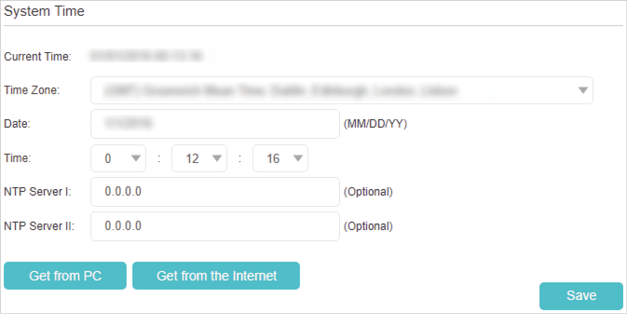
3.Configure the system time using the following methods :
Manually - Select your time zone and enter your local time.
Get from PC - Click this button if you want to use the current managing PC’s time.
Get from the Internet - Click this button if you want to get time from the internet. Make sure your router can access the internet before you select this way to get system time.
4.Click Save to make your settings effective.
5.After setting the system time, you can set Daylight Saving time according to your needs. Tick the checkbox to enable Daylight Saving, set the start and end time and then click Save to make the settings effective.

TP-Link is dedicated to improving and richening the product features, giving you a better network experience.
We will inform you through the web management page if there’s any update firmware available for your router. Also, the latest firmware will be released at TP-Link official website, you can download it from the Support page of our website www.tp-link.com for free.
Note:
1.Make sure that you have a stable connection between the router and your computer. It is NOT recommended to upgrade the firmware wirelessly.
2.Make sure you remove any USB storage device connected to the router before the firmware upgrade to prevent data loss.
3.Back up your router configuration before upgrading the firmware.
4.Do NOT turn off the router during the firmware upgrade.
2.1. Online Upgrade
1.Visit http://tplinkmodem.net, and log in with the password you set for the router.
2.If there’s any firmware update available for your router, the update icon will display on the top-right corner of the page. Click the icon to go to the Firmware Upgrade page.
Alternatively, you can go to Advanced > System Tools > Firmware Upgrade, and click Check for Upgrades to see if there’s any new firmware.

Tips:
If there’s any new important firmware update for your router, you will see the notification (similar as shown below) on your computer when open a new web page. Click Upgrade Now, and log in to the web management page. You will see the Firmware Upgrade page.

3.Focus on the Online Upgrade section, and click Upgrade.

4.Wait a few moments for the upgrading and rebooting.
2.2. Local Upgrade
1.Download the latest firmware file for the router from our website www.tp-link.com.
2.Visit http://tplinkmodem.net, and log in with the password you set for the router.
3.Go to Advanced > System Tools > Firmware Upgrade.
4.Focus on the Device Information section. Make sure the downloaded firmware file matches with the Hardware Version.
5.Focus on the Local Upgrade section. Click Browse to locate the downloaded new firmware file, and click Upgrade.

6.Wait a few moments for the upgrading and rebooting.
3. Back up and Restore Configuration Settings
The configuration settings are stored as a configuration file in the router. You can back up the configuration file to your computer for future use and restore the router to a previous settings from the backup file when needed. Moreover, if needed you can erase the current settings and reset the router to the default factory settings.
•To back up configuration settings:
1.Visit http://tplinkmodem.net, and log in with the password you set for the router.
2.Click Advanced > System Tools > Backup & Restore page.
3.Click Backup to save a copy of the current settings to your local computer. A conf.bin file will be stored to your computer.
•To restore configuration settings:
1.Visit http://tplinkmodem.net, and log in with the password you set for the router.
2.Click Advanced > System Tools > Backup & Restore page.
3.Click Browse to locate the previous backup configuration file, and click Restore.
4.Wait for the restoring and then the router will automatically reboot.
•To reset the router to factory default settings:
1.Visit http://tplinkmodem.net, and log in with the password you set for the router.
2.Click Advanced > System Tools > Backup & Restore page.
3.Click Factory Restore to reset the router.
4.Wait for the resetting and then the router will automatically reboot.
Note:
1.Do not interrupt or turn off the router during the resetting process.
2.We strongly recommend you to back up the current configuration settings before resetting the router.
4. Change the Administrator Account
Admin account is used to log in to the router’s web-based management page. You are required to set the admin account at the first login. You can change it on the web page.
1.Visit http://tplinkmodem.net, and log in with the password you set for the router.
2.Go to Advanced > System Tools > Administration page. Locate the Account Management section.
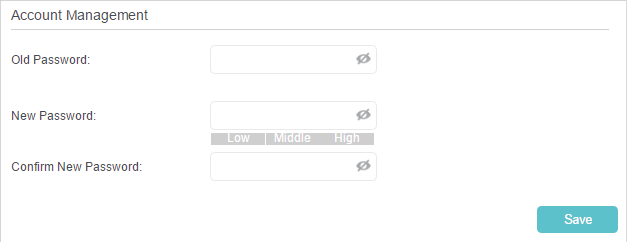
3.Enter the old password. Enter the new password and enter again to confirm.
4.Click Save to make the settings effective.
You can control the local devices’ authority to manage the router via the Local Management feature. By default all local connected devices are allowed to manage the router. You can also allow only one device to manage the router.
Follow the steps below to specify the local management.
1.Visit http://tplinkmodem.net, and log in with the password you set for the router.
2.Go to Advanced > System Tools> Administration page. Locate the Local Management section.

3.Enable Local Management via HTTPS if you want to access the router via both HTTPS and HTTP, or keep it disabled if you only want to access the router via HTTP.
4.Keep the Port for HTTP and Port for HTTPS as the default settings.
5.If you only want to allow one specific device to manage the router, enable Only Allow the Following IP/MAC and then enter the IP Address or MAC Address of the device in the IP/MAC Address field.
6.Click Save to make the settings effective.
By default, the remote devices are not allowed to manage the router from the internet.
Follow the steps below to allow remote devices to manage the router.
1.Visit http://tplinkmodem.net, and log in with the password you set for the router.
2.Go to Advanced > System Tools > Administration page. Locate the Remote Management section.
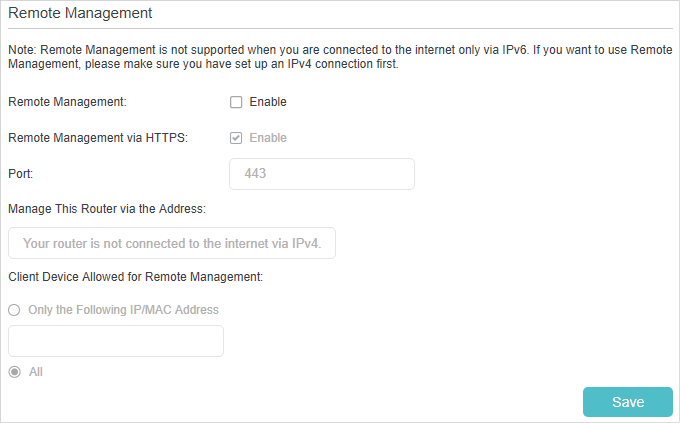
3.Enable Remote Management if you want to allow Remote Management via HTTPS, or enable Remote Management and then disable Remote Management via HTTPS if you only want to allow Remote Management via HTTP.
4.Keep the Port as the default setting.
5.If you only want to allow one specific device to manage the router, select Only the Following IP/MAC Address and then enter the IP Address or MAC Address. If you want to allow all remote devices can access the router, select All.
6.Click Save to make the settings effective.
Tips:
1.You can find the WAN IP address of the router on Basic > Network Map > Internet.
2.The router’s WAN IP is usually a dynamic IP. Please refer to Set Up a Dynamic DNS Service Account if you want to log in to the router through a domain name.
System Log can help you know what happens to your router, facilitating you to locate the malfunctions. For example when your router does not work properly, you will need to save the system log and send it to the technical support for troubleshooting.
1.Visit http://tplinkmodem.net, and log in with the password you set for the router.
2.Click Advanced > System Tools > System Log page.
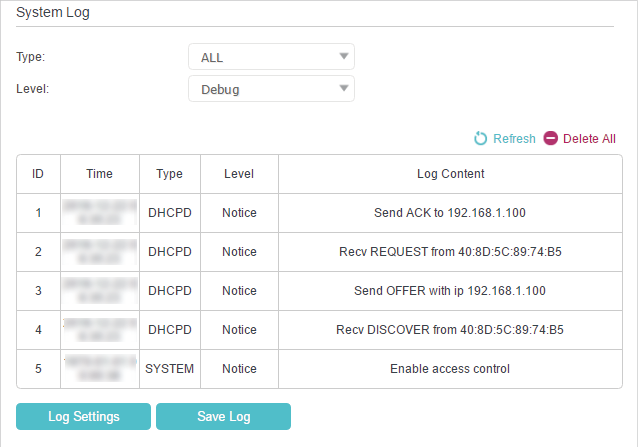
•To view the system logs:
1.Select the log Type. Select ALL to view all kinds of logs, or select DHCPD or IGMP to view the specific logs.
2.Select the log Level and you will see the logs with the specific or higher levels.
3.Click Refresh to refresh the log list.
•To save the system logs:
You can choose to save the system logs to your local computer or a remote server.
1.Click Save Log to save the logs in a txt file to your computer.
2.Click Log Settings to set the save path of the logs.
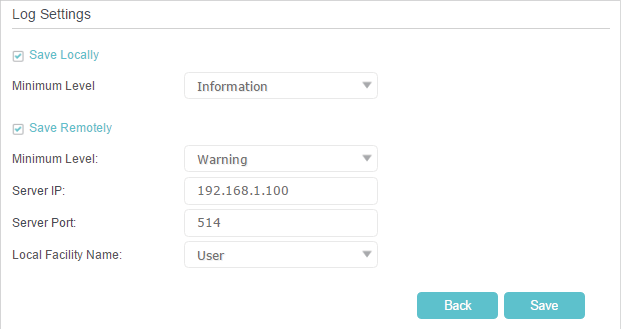
•Save Locally - Select this option to cache the system log to the router’s local memory, select the minimum level of system log to be saved from the drop-down list. The logs will be shown in the table in descending order on the System Log page.
•Save Remotely - Select this option to send the system log to a remote server, select the minimum level of system log to be saved from the drop-down list and enter the information of the remote server. If the remote server has a log viewer client or a sniffer tool implemented, you can view and analyze the system log remotely in real-time.
8. Monitor the Internet Traffic Statistics
The Traffic Monitor page displays the network traffic of the LAN, WAN and WLAN sent and received packets, allowing you to monitor the volume of internet traffic statistics.
1.Visit http://tplinkmodem.net, and log in with the password you set for the router.
2.Go to Advanced > System Tools > Statistics page.
3.Toggle on Traffic Monitor, and then you view the traffic usage of a device in the past 10 minutes or that of all devices in the past 10 minutes/24 hours/7 days.
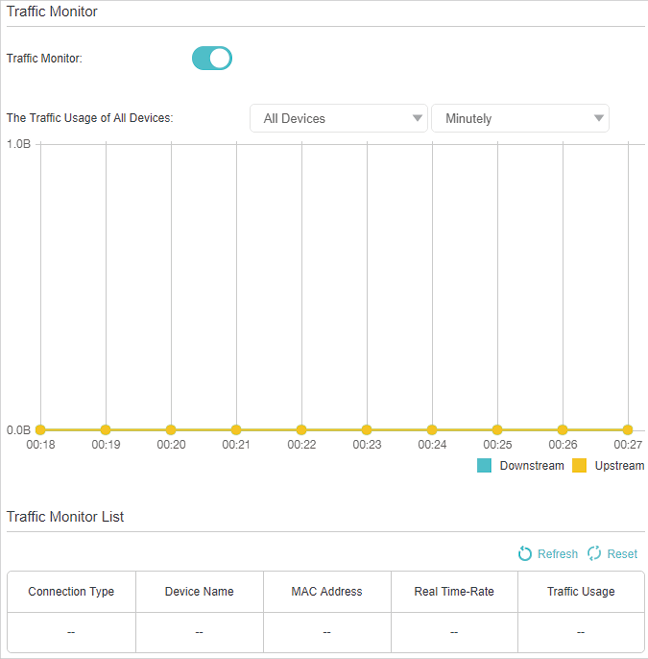
The router offers CWMP feature. The function supports TR-069 protocol which collects information, diagnoses the devices and configures the devices automatically via ACS (Auto-Configuration Server).
1.Visit http://tplinkmodem.net, and log in with the password you set for the router.
2.Go to Advanced > System Tools > CWMP Settings page.
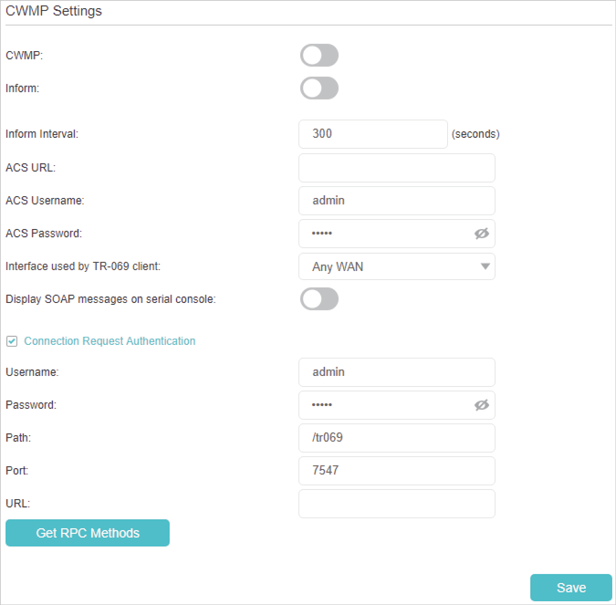
•Enable CWMP - Toggle On to enable the CWMP (CPE WAN Management Protocol) feature.
•Inform - Enable this feature to send an Inform message to the ACS (Auto Configuration Server) periodically.
•Inform Interval - Enter the time in seconds when the Inform message will be sent to the ACS.
•ACS URL - Enter the web address of the ACS which is provided by your ISP.
•ACS Username/Password - Enter the username/password to log in to the ACS server.
•Interface used by TR-069 client - Select which interface to be used by the TR-069 client.
•Display SOAP messages on serial console - Toggle to enable or disable this feature.
•Connection Request Authentication - Select this checkbox to enable authentication for the connection request.
•Username/Password - Enter the username/password for the ACS server to log in to the router.
•Path - Enter the path for the ACS server to log in to the router.
•Port - Enter the port that connects to the ACS server.
•URL - Enter the URL that connects to the ACS server.
•Get RPC Methods - Click to get the methods to support CWMP.
3.Click Save to make the settings effective.
SNMP (Simple Network Management Protocol) has been widely applied in the computer networks currently, which is used for ensuring the transmission of the management information between two nodes. In this way, network administrators can easily search and modify the information on any node on the network. Meanwhile, they can locate faults promptly and implement the fault diagnosis, capacity planning and report generating.
An SNMP Agent is an application running on the router that performs the operational role of receiving and processing SNMP messages, sending responses to the SNMP manager, and sending traps when an event occurs. So a router contains SNMP “agent” software can be monitored and/or controlled by SNMP Manager using SNMP messages.
1.Visit http://tplinkmodem.net, and log in with the password you set for the router.
2.Go to Advanced > System Tools > SNMP Settings page.
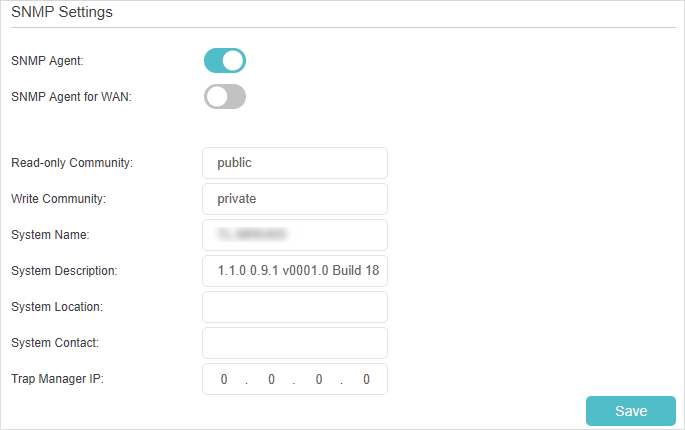
•Enable SNMP Agent/SNMP Agent for WAN - Toggle On to enable the built-in SNMP agent that allows the router to operate as the operational role in receiving and processing of SNMP messages, sending responses to the SNMP manager, and triggering SNMP traps when an event occurs.
•Read-only Community - Displays the default public community string that protects the router from unauthorized access.
•Write Community - Displays the default read and write community string that protects the router from unauthorized changes.
•System Name - Displays the administratively-assigned name for this managed device.
•System Description - Displays the textual description of the managed device. This value should include the full name and version identification of the system’s hardware type, software operating-system, and networking software.
•System Location - Displays the physical location of this device (e.g. telephone closet, 3rd floor).
•System Contact - Displays the textual identification of the contact person for this managed device, together with information on how to contact this person.
•Trap Manager IP - Displays the IP address of the host to receive the traps.
3.It is recommended to keep the default settings. Click Save to make the settings effective.